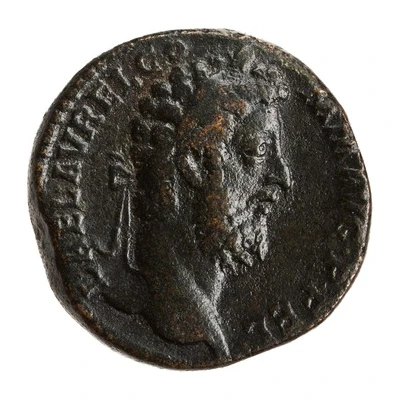


© American Numismatic Society (ANS)
Sestertius - Commodus LIB AVG P M TR P XVII IMP VIII COS VII P P S C; Liberalitas
192 year| Bronze | 27.5 g | 30 mm |
| Issuer | Rome › Roman Empire (27 BC - 395 AD) |
|---|---|
| Emperor | Commodus (Lucius Aurelius Commodus) (177-192) |
| Type | Standard circulation coin |
| Year | 192 |
| Value | 1 Sestertius = ¼ Denarius |
| Currency | Denarius, Reform of Augustus (27 BC – AD 215) |
| Composition | Bronze |
| Weight | 27.5 g |
| Diameter | 30 mm |
| Shape | Round (irregular) |
| Technique | Hammered |
| Demonetized | Yes |
| Updated | 2024-10-06 |
| Numista | N#266014 |
|---|---|
| Rarity index | 100% |
Reverse
Commodus, togate, seated left on curule chair on platform, attended by an officer; before him, Liberalitas, draped, standing left, holding tessera in right hand and corncuopiae in left hand; at left, citizen mounting right steps of platform.
Script: Latin
Lettering: LIB AVG P M TR P XVII IMP VIII COS VII P P S C
Translation:
Liberalitas Augustorum, Pontifex Maximus, Tribunicia Potestate Septima Decima, Imperator Octavum, Consul Septimum, Pater Patriae. Senatus Consultum.
The liberality of the emperor (Augustus), high priest, holder of tribunician power for the 17th time, supreme commander (Imperator) for the eighth time, consul for the seventh time, father of the nation. Decree of the senate.
Comment
Mass varies: 25.32–29.62 g;Example of this type:
American Numismatic Society (ANS)
Source:
Online Coins of the Roman Empire (OCRE)
Interesting fact
One interesting fact about this coin is that it features an image of the Roman goddess Liberalitas, which represents the concept of liberty or freedom, on its reverse side. This is fitting, given that the coin was issued during the reign of Emperor Commodus, who was known for his extravagance and excesses, and the image of Liberalitas may have been a symbol of the freedom and prosperity that the Roman Empire enjoyed during his rule.